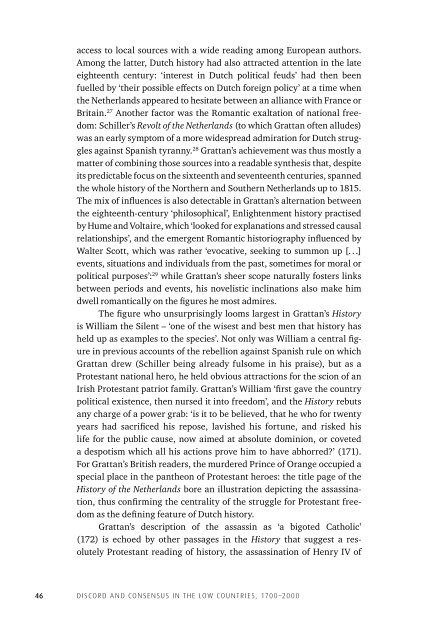Discord Consensus
7aze300jFJo
7aze300jFJo
You also want an ePaper? Increase the reach of your titles
YUMPU automatically turns print PDFs into web optimized ePapers that Google loves.
access to local sources with a wide reading among European authors.<br />
Among the latter, Dutch history had also attracted attention in the late<br />
eighteenth century: ‘interest in Dutch political feuds’ had then been<br />
fuelled by ‘their possible effects on Dutch foreign policy’ at a time when<br />
the Netherlands appeared to hesitate between an alliance with France or<br />
Britain. 27 Another factor was the Romantic exaltation of national freedom:<br />
Schiller’s Revolt of the Netherlands (to which Grattan often alludes)<br />
was an early symptom of a more widespread admiration for Dutch struggles<br />
against Spanish tyranny. 28 Grattan’s achievement was thus mostly a<br />
matter of combining those sources into a readable synthesis that, despite<br />
its predictable focus on the sixteenth and seventeenth centuries, spanned<br />
the whole history of the Northern and Southern Netherlands up to 1815.<br />
The mix of influences is also detectable in Grattan’s alternation between<br />
the eighteenth-century ‘philosophical’, Enlightenment history practised<br />
by Hume and Voltaire, which ‘looked for explanations and stressed causal<br />
relationships’, and the emergent Romantic historiography influenced by<br />
Walter Scott, which was rather ‘evocative, seeking to summon up [. . .]<br />
events, situations and individuals from the past, sometimes for moral or<br />
political purposes’: 29 while Grattan’s sheer scope naturally fosters links<br />
between periods and events, his novelistic inclinations also make him<br />
dwell romantically on the figures he most admires.<br />
The figure who unsurprisingly looms largest in Grattan’s History<br />
is William the Silent –‘one of the wisest and best men that history has<br />
held up as examples to the species’. Not only was William a central figure<br />
in previous accounts of the rebellion against Spanish rule on which<br />
Grattan drew (Schiller being already fulsome in his praise), but as a<br />
Protestant national hero, he held obvious attractions for the scion of an<br />
Irish Protestant patriot family. Grattan’s William ‘first gave the country<br />
political existence, then nursed it into freedom’, and the History rebuts<br />
any charge of a power grab: ‘is it to be believed, that he who for twenty<br />
years had sacrificed his repose, lavished his fortune, and risked his<br />
life for the public cause, now aimed at absolute dominion, or coveted<br />
a despotism which all his actions prove him to have abhorred?’ (171).<br />
For Grattan’s British readers, the murdered Prince of Orange occupied a<br />
special place in the pantheon of Protestant heroes: the title page of the<br />
History of the Netherlands bore an illustration depicting the assassination,<br />
thus confirming the centrality of the struggle for Protestant freedom<br />
as the defining feature of Dutch history.<br />
Grattan’s description of the assassin as ‘a bigoted Catholic’<br />
(172) is echoed by other passages in the History that suggest a resolutely<br />
Protestant reading of history, the assassination of Henry IV of<br />
46<br />
DISCORD AND CONSENSUS IN THE LOW COUNTRIES, 1700–2000


